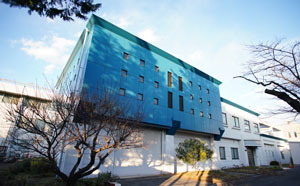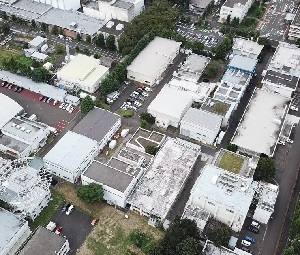|
“I belong to the ‘Preventive Safety’ (field),” says Vice-Director Sekine. Originally a specialist in psychology, he has long been involved in research on the driver’s driving behavior, the influence of psychological characteristics on driving, and Human Machine Interface (HMI) of automobiles based on the characteristics of visual and auditory functions. According to him, he has developed these approaches, and in recent years, has focused on research into the driving characteristics of the elderly and how to lead them to safety assurance, and is involved in a wide range of research from the perspective of project management.
On the other hand, Ms. Yoko Kato, Researcher in the same Dept. plays a central role in the use of UC-win/Road DS within Automotive Safety Research Dept. Reflecting her experience of consistently studying architectural lighting, light, and visibility therein since her student days, she has been participating in research related to elderly drivers, human factors, and automobile lighting since her arrival at NTSEL.
UC-win/Road DS Adopted for Evaluating Elderly Drivers
NTSEL has been using DS for research for about 20 years. The DS was introduced in 2003, around the time Vice-Director Sekine joined NTSEL. While the driver's seat was similar to that of a real car, the monitor had a narrow field of view and only one screen, and the system was operated by a member who was good at programming while modifying the program of the first system. Although the system was mainly used to evaluate automotive HMI in general, he recalls that it was still not easy to adapt it to the needs of the experiment.
In recent years, research related to autonomous driving has emerged as a priority theme. With the budget expected to be allocated for this research, NTSEL decided to revamp the existing DS for autonomous driving, which was hard to treat with the existing DS, as well as for research on the elderly, for which there was also a growing need within NTSEL. While utilizing the hardware of the existing DS such as the driver's seat and vehicle body as much as possible, the viewing angle of the front monitor was widened and its resolution was increased to ensure a rear view newly. In addition, they summarized their requests. For example, they wanted to reuse Head-up Display (HUD) device from the existing DS for the new DS again, and they wanted to have the new DS designed in such a way that the HUB device does not interfere with the projector image. Based on these requests, they invited applications from the public in 2018 and received applications from several companies. Forum8's UC-win/Road DS was selected because it met all the requisites and the cost was within the budget.
Subsequently, when the in-process research that required the use of the existing DS came to an end at the end of January 2019, they began renovating the DS. After moving the existing DS to an adjacent room that would serve as the new installation site, it was constructed as a new-generation stationary DS in March of the same year after a net two-month preparation period.
 |
| Capable of acquiring data on the subjects' steering operation, pedal operation, gaze measurement, etc. in response to respective events |
Female Researcher Started Working on VR after Her Arrival, Creating Scenarios for Experimental Purposes
| Researcher Kato joined NTSEL in April after the introduction of the new DS. It was the first time for everyone in the dept. to use the DS. The DS operation system was formed with Ms. Kato at the center right after her arrival, with the aim of "having her learn automobile technology as well as simulator operation" (Vice-Director Sekine). Mr. Sekine, who is in charge of the research teams using the DS, is taking part in the system, and so are the students from Tokyo University of Agriculture and Technology and Chuo University through the Joint Graduate School system and joint research with external organizations.
The first case study using the DS is an experiment on elderly drivers. This was a request from a university hospital with which they were conducting joint research to find out what precautions should be taken when driving in an urban area nearby where elderly people live. In the spring of the same year, Researcher Kato began creating a VR for DS. First, she created an imaginary urban space by imitating the width of the community roads and building landscape in the Mitaka City area. Next, she created a one-kilometer route with one-lane on each side, with one or two events that tend to occur in daily life, such as rush-out of children or a cyclist’s overtaking, while driving along the route. She created seven experimental scenarios by the end of the summer, each with the same route but different events and combinations of events. In addition, a system was built to measure the reaction time and line of sight of the subject while operating the DS, to check pedal operation using video images, and to acquire data such as driving speed, trajectory, and distance from the preceding vehicle through the logs of UC-win/Road. In the fall, an experiment using the DS was conducted in cooperation with the Mitaka Silver Human Resource Center.
|
|
|
|
Also in fiscal 2019, as part of the Human Factors, an experiment was conducted to evaluate the impact of HMI and secondary tasks when autonomous driving is switched to manual driving. Researcher Kato used VR to represent a scenario in which a driver drives in an autonomous vehicle on an imaginary expressway for several minutes, followed by an audible cue to switch to manual driving. when secondary tasks, such as operation of smartphone, are imposed on the driver during automated driving.
In fiscal 2020, Researcher Kato took charge of experiments of road projection lamp, which overlapped with her own field of expertise. She evaluated the effects on the drivers of owner-driven cars and other traffic participants when driver assistance information was drawn on the road surface in front of the vehicle using headlight distribution. In this experiment, a virtual display plug-in was used to display the road projection. The experiment examined whether the driver's reaction to the brake lighting of the vehicle ahead would be delayed when the driver gazes at the road surface. Utilizing DS, they plan to continue to study the effectiveness and safety of the road projection lamp.
|
Evaluate the Support System and Optional functions
“Basically, I can do what I want to do. That's my honest impression (of the DS).”
When the simulator was first introduced three years ago, the number of screens increased and the system was changed to one that could be driven simultaneously with multiple PCs linked together compared with the former simulator that had a relatively simple configuration. Consequently, they were faced with new challenges such as adjustment of these issues. However, these issues were gradually resolved thanks to a strong support system in which Forum8's staff, who knew the specifications of the DS they owned, responded promptly and accurately as needed when contacted. In addition, for needs that seemed difficult to meet with the basic configuration, it was customized using plug-ins options such as HUD (virtual display). Support for experiments that “they wanted to conduct,” such as image display like the road projection lamp, was also facilitated. Moreover, when conducting their own experiments, they often need to combine various external systems, controlling and timing them. In this respect, the DS is equipped with a mechanism that supports such functions from the beginning. “This made it possible to realize it relatively easily,” says Vice-Director Sekine.
On the other hand, with the experiment of using road projection lamp as an example, he also mentioned the merits of using VR to reproduce and evaluate technologies that have not yet been put to practical use or are difficult to implement in actual vehicles. As an extension of the above, he also mentioned the possibility of applying the DS to: 1) evaluation of HMI that transmits information from the autonomous driving car to drivers and pedestrians in the surrounding area; 2) evaluation of what kind of travelling conditions makes the driver dazzled, when brightness of the headlamp is getting higher and higher; and 3) evaluation based on different operability between gasoline vehicles and Electric Vehicles (EVs).
|




